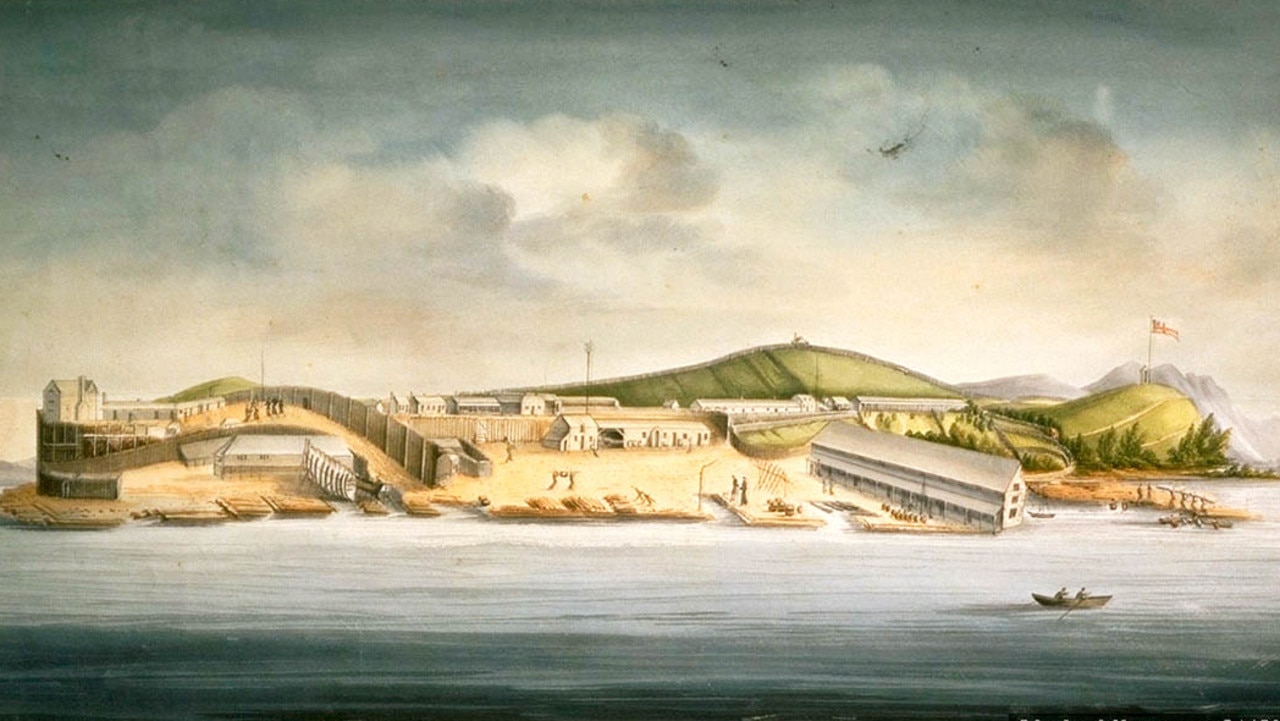‘We ate each other one by one’: The gruesome story of Alexander Pearce the cannibal convict
When eight men escaped Australia’s most notorious prison, only one was found alive. This is the gory story of what happened to the rest.
When 29-year-old Irishman Alexander Pearce landed in Van Diemen’s Land in 1819 to begin a seven-year sentence for stealing six pairs of shoes, he quickly hatched a plan to escape.
Two years later he managed to flee, but, when he was captured again, he was sent to the most brutal penal settlement of all; Sarah Island on the remote Macquarie Harbour.
Desperate to escape the horrors of his life in captivity where he endured multiple beatings by sadistic guards, Pearce vowed to escape once more.
Incredibly, he managed to get away, along with seven other convicts.
But, after more than 100 days on the run he was eventually captured, 197 years ago this month.
However, Pearce was the only man out of eight who survived. He told his captors that he and his fellow convicts were forced to eat each other to survive, killing each other and devouring carcasses one by one.
But nobody believed him.
It wasn’t until he escaped a third time and body parts were found on him upon his recapture that police officers realised he’d been telling the truth all along.
Pearce has gone down in history as being one of Australia’s most notorious convicts because there was one major factor that distinguished him from everybody else: He was a self-confessed cannibal.
RELATED: The grotesque story of the Second Fleet
RELATED: The bushranger who trained Ned Kelly
RELATED: Paris attacks: Woman fakes being victim, jailed for fraud

The early years
Not much is known about Alexander Pearce’s early life. He was born in County Monaghan, Ireland, in 1790 and worked as a farm labourer.
According to Pearce’s convict records, he was 5 ft 3, which was considered just below average height in those days, with “pock-pitted skin”, brown hair and hazel eyes.
Pearce was convicted and tried in County Armagh in 1819 for larceny (stealing shoes) and sentenced to penal transportation to Van Diemen’s Land (today’s Tasmania).
As if being transported to a penal colony wasn’t bad enough, once he arrived, Pearce got himself into a whole new world of trouble.
According to convict records, Pearce broke the law four times in 1821, earning him a total of 175 lashes.
The First Escape
In May, 1822, Pearce escaped from prison and, according to the Hobart Town Gazette a £10 reward was placed for his capture. When he was caught, he was charged with absconding and received a second sentence of transportation, this time to the new penal establishment at Sarah Island, which was said to be a hell hole.
Sarah Island, on the west coast of Tasmania, was seen as the best place to imprison the most rebellious convicts due to its remote location. The surrounding waters were so treacherous only a small number of convicts ever arrived, because several ships were wrecked as they attempted the narrow sea passage.
Sarah Island was said to be absolutely unbearable, with limited supplies, freezing cold weather, frequent whippings and gruelling labour, so it’s no wonder the prisoners tried to escape.
Less than eight weeks after his arrival, Pearce and seven other convicts, were on the run. Pearce’s’ group included Alexander Dalton, Thomas Bodenham, William Kennerly, Matthew Travers, Edward Brown, Robert Greenhill and John Mather.
The men were cutting pine logs when they overpowered their supervisor and bolted into the bush. But the odds were already stacked against them when they set off with woefully inadequate supplies for a journey through some of Australia’s most hostile, unexplored lands.
The initial plan was to find a boat and sail north out of Macquarie Harbour, towards a Pacific island. But the plan was never going to work because the men ran into the rainforests surrounding the harbour, heading east.
Even today, it’s land that only experienced bush walkers would attempt to hike through. According to convict records, ten days into the journey, the men realised they wouldn’t survive any longer unless they had food. After 110 days on the loose, Pearce was recaptured alone, after making it to the other side of Tasmania.

Cannibalism
When officials quizzed Pearce as to the whereabouts of his fellow escapees, he confessed that he and the other men had killed and then cannibalised each other one by one until he was the lone survivor.
They’d gone 15 days without food and could see no other way of staying alive. Pearce told officials that once only he and Robert Greenhill were left, he waited until Greenhill fell asleep and killed him with an axe, before consuming his remains.
Pearce had made it to a settled district where he was helped by a former convict who was working as a shepherd. He survived for several weeks by robbing farms and stealing sheep before he was recaptured.
But Pearce’s cannibal confession fell on deaf ears and nobody believed his grisly tale. It was simply too farfetched and too horrendous to take seriously.
Instead, officials thought Pearce had made up the story to cover for his friends who were most likely hiding out somewhere in the Tasmanian Wilderness, surviving as bushrangers.
Pearce was returned to Sarah Island where he plotted yet another escape with a young convict, Thomas Cox.
This time, Pearce was captured after just ten days on the run. There was no sign of Cox so, once again Pearce told officers he’d killed and cannibalised Cox.
It was only when human flesh was found in Pearce’s pockets that his grisly story was actually believed. Pearce told prison officers he murdered Cox during a heated argument that broke out when they reached a river crossing and Cox admitted he couldn’t swim. Pearce realised that Cox was a hindrance and a liability.
After he murdered Cox, Pearce cannibalised his carcass. When he returned to Sarah Island, Pearce was charged with murdering and cannibalising Cox and sentenced to death by hanging.
The last confession
In 2008, Nial Fulton wrote the Tasmanian documentary, The Last Confession of Alexander Pearce. Much of the script was taken from Pearce’s confession so the documentary is as close to the truth that we have of what happened to Pearce and what he thought about his brutal imprisonment and multiple escapes.
Fulton told news.com.au he believes the real heart of the story is the story of the depravity inflicted on prisoners in Australia.
“We always talk about the notion of ‘What would you do to survive if you were in his position?’ Pearce was a man stripped of all humanity by the penal system of Tasmania. These men were not only taken out of Ireland but taken away from the mainland of Australia and put on an island. They had no hope, literally no hope of freedom, or of ever seeing Ireland again,” Fulton said.
“The real cruelty in Pearce’s story was of that inflicted on the convicts of the system designed to break human beings. In Port Arthur, they calculated how much food a prisoner needed to stay alive and they gave them only that, the absolute minimum. It was like a mathematics equation, with everything designed to inflict physical and psychological torture.”
The Last Confession of Alexander Pearce focuses on the three days before Pearce is executed, when he calls for a priest and realised that the priest came from the same town in Ireland as Pearce. Fulton said he wanted to explore how a priest can grant absolution to a man who openly admitted killing and eating people.
“There’s a scene where the priest explains why the cruelty of the British establishment made Pearce who he was. If Alexander Pearce hadn’t existed, they would have had to invent him as he represented the ‘bogey man’ in a fledging society. You always have to have evil in society because it keeps society whole; if you don’t adhere to the rules you’ll become this monster,” Fulton said.

At Pearce’s trial, witnesses said showed signs of repentance. He had no defence counsel and there’s no record of him saying anything on his own behalf. The trial was brief and the inevitable verdict was handed down.
Pearce was hanged on July 19, 1824, then his body was taken to surgeons for dissection, which was what usually happened to the carcass of murderers in those days.
Pearce’s skull ended up in the US as part of the collection of infamous physician and anthropologist Dr. Samuel George Morton, who believed that cranial capacity determined intellectual ability.
By 1968, Pearce’s skull ended up at the University of Pennsylvania where it remains to this day.
The story of Pearce the cannibal convict is one of the biggest gothic horror stories of our convict past.
But, beyond the gory story, it’s also a tale of survival of a man who, like many convicts, did not deserve such a harsh sentence for a petty crime that hurt no one.
— LJ Charleston is a freelance historical writer. Continue the conversation @LJCharleston



